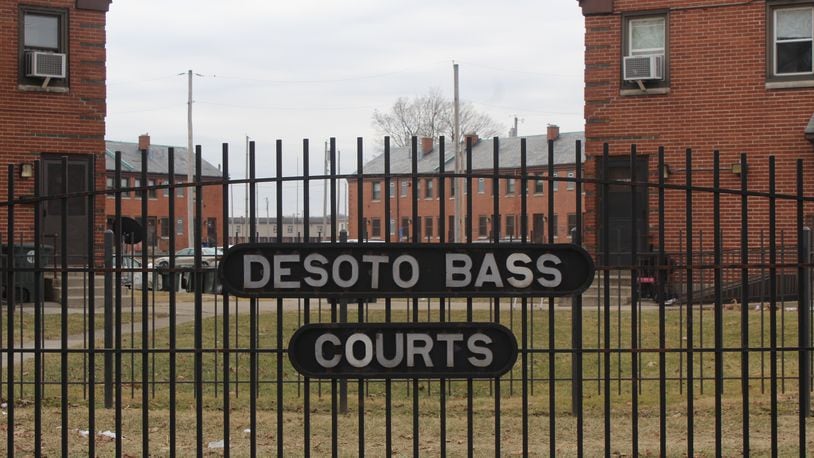There’s demand for up to nearly 1,000 new housing units, including a mix of subsidized, senior, market rate and for-sale units, according to a market study done for the agency.
RELATED: $1.5M from feds targets changes for DeSoto Bass, West Dayton
Residents who live in the area, which is home to DeSoto Bass Courts and Hilltop Homes, also say they want community gardens, a grocery store, a laundromat and increased police presence and visibility, according to a survey of a public housing residents and some neighbors.
“The plan’s goals are to improve people’s lives in the categories of people, housing and neighborhoods,” said Michael Melko, an intern with GDPM.
GDPM’s “transformation plan” will be submitted to the federal government, which in the past has awarded tens of millions of dollars to communities to implement their plans and help pay for new housing, amenities and other investments.
The Trump administration’s current budget does not have funding for implementation, but even without that money, GDPM hopes to remake this part of Dayton, though likely it would take longer and require adjustments, agency officials said.
TRENDING: Area libraries institute bans, tighten security
“We have alternate plans for our housing if we are not fortunate enough to receive this Choice Neighborhood funding,” said Jennifer Heapy, CEO of GDPM. “We are still committed to a transformation for that particular part of the city — it’ll just take us longer.”
In June 2016, the U.S. Department of Housing and Urban Development (HUD) awarded GDPM and the city of Dayton $1.5 million to craft a plan to transform the DeSoto Bass Courts and Hilltop Homes public housing projects as well as the surrounding neighborhoods, known as the “choice target area.”
Built in 1942, DeSoto Bass is the largest remaining public housing project in the Dayton area. DeSoto and Hilltop have more than 550 public housing units.
MORE: Wright State faculty angered by planned cuts; ‘terrible decisions’ loom
Using HUD’s planning grant, GDPM paid for a market study and feasibility analysis to evaluate housing, demographic and economic factors that impact housing and other development.
The analysis includes recommendations about suitable housing product and investments in the choice target area, which includes the Edgemont, Miami Chapel, Lakeview, Madden Hills and Pineview neighborhoods.
“A portion of this is about housing — so looking at where would good sites be for creating new housing opportunities,” said Nicole Steele, project manager with CityWide, which is the planning coordinator for the federal grant.
RELATED: Dayton public housing project awarded $2.4M federal grant
The market study found significant demand for new housing. It estimates that the area could use:
• 70 to 100 new market-rate units
• 20 to 55 for-sale units for households at 80 to 120 percent of area median income (AMI)
• 140 to 190 new low-income units for families between 40 to 60 percent of AMI
• 50 to 70 low-income units for seniors between 40 to 60 percent of AMI
• 240 to 320 subsidized units for families below 30 percent of AMI
• 180 to 260 units for seniors below 30 percent of AMI
There could be mixed-use developments, featuring ground floor commercial or retail space, and the plan identifies community assets that little pockets of housing could be clustered around and vacant land that could support new housing, Steele said.
MORE: Son’s message to honor his late Dayton mother: Be kind to one another
But the transformation plan also is intended to improve economic and health conditions for residents as well.
Public housing residents in the area were surveyed and identified a grocery store and laundromat as the top retail needs.
Two-thirds of residents said sometimes they did not have enough food in their homes, and residents said they were most concerned about safety and want a stronger police presence.
Other residents of the area who were not in public housing said they would like more police visibility and wished for restaurants, a grocery store or a farmer’s market nearby.
The choice neighborhood area is economically distressed. The median income of its residents is $19,368, $9,375 below the city as a whole, according to data from GPDM. Public housing residents in the area have a median income of $6,714.
Some of the $1.5 million planning grant will pay for action steps to improve the neighborhood include infrastructure enhancements along a 1-mile stretch of Germantown Street, new murals and lighting and facade upgrades for the business corridor, said Kiya Patrick, GDPM’s senior manager of planning and development.
HUD right now does not have funding available for implementing choice neighborhood plans, but GDPM may try to convert DeSoto Bass and Hilltop into Section 8 housing under a special program, officials said.
That would make the properties eligible to receive tax credits and private capital sources, which can help pay facility repairs, renovations or new housing.
West Dayton could use some good news. Aldi’s in the Westtown Shopping Center late last year announced it is closing.
Good Samaritan Hospital, in northwest Dayton, has announced it will close, likely by the end of this year.
About the Author
